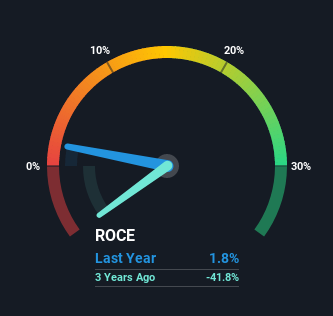- Germany
- /
- Healthtech
- /
- XTRA:IS8
Returns On Capital Signal Difficult Times Ahead For ifa systems (ETR:IS8)

What financial metrics can indicate to us that a company is maturing or even in decline? Businesses in decline often have two underlying trends, firstly, a declining return on capital employed (ROCE) and a declining base of capital employed. Trends like this ultimately mean the business is reducing its investments and also earning less on what it has invested. In light of that, from a first glance at ifa systems (ETR:IS8), we've spotted some signs that it could be struggling, so let's investigate.
Understanding Return On Capital Employed (ROCE)
If you haven't worked with ROCE before, it measures the 'return' (pre-tax profit) a company generates from capital employed in its business. The formula for this calculation on ifa systems is:
Return on Capital Employed = Earnings Before Interest and Tax (EBIT) ÷ (Total Assets - Current Liabilities)
0.018 = €224k ÷ (€17m - €4.7m) (Based on the trailing twelve months to June 2021).
Thus, ifa systems has an ROCE of 1.8%. Ultimately, that's a low return and it under-performs the Healthcare Services industry average of 9.9%.
Check out our latest analysis for ifa systems

Above you can see how the current ROCE for ifa systems compares to its prior returns on capital, but there's only so much you can tell from the past. If you'd like, you can check out the forecasts from the analysts covering ifa systems here for free.
What Can We Tell From ifa systems' ROCE Trend?
The trend of ROCE at ifa systems is showing some signs of weakness. Unfortunately, returns have declined substantially over the last five years to the 1.8% we see today. In addition to that, ifa systems is now employing 52% less capital than it was five years ago. The combination of lower ROCE and less capital employed can indicate that a business is likely to be facing some competitive headwinds or seeing an erosion to its moat. Typically businesses that exhibit these characteristics aren't the ones that tend to multiply over the long term, because statistically speaking, they've already gone through the growth phase of their life cycle.
On a side note, ifa systems' current liabilities have increased over the last five years to 28% of total assets, effectively distorting the ROCE to some degree. Without this increase, it's likely that ROCE would be even lower than 1.8%. While the ratio isn't currently too high, it's worth keeping an eye on this because if it gets particularly high, the business could then face some new elements of risk.
The Bottom Line On ifa systems' ROCE
In summary, it's unfortunate that ifa systems is shrinking its capital base and also generating lower returns. Long term shareholders who've owned the stock over the last five years have experienced a 56% depreciation in their investment, so it appears the market might not like these trends either. Unless there is a shift to a more positive trajectory in these metrics, we would look elsewhere.
If you want to know some of the risks facing ifa systems we've found 2 warning signs (1 is a bit unpleasant!) that you should be aware of before investing here.
While ifa systems may not currently earn the highest returns, we've compiled a list of companies that currently earn more than 25% return on equity. Check out this free list here.
Valuation is complex, but we're here to simplify it.
Discover if ifa systems might be undervalued or overvalued with our detailed analysis, featuring fair value estimates, potential risks, dividends, insider trades, and its financial condition.
Access Free AnalysisHave feedback on this article? Concerned about the content? Get in touch with us directly. Alternatively, email editorial-team (at) simplywallst.com.
This article by Simply Wall St is general in nature. We provide commentary based on historical data and analyst forecasts only using an unbiased methodology and our articles are not intended to be financial advice. It does not constitute a recommendation to buy or sell any stock, and does not take account of your objectives, or your financial situation. We aim to bring you long-term focused analysis driven by fundamental data. Note that our analysis may not factor in the latest price-sensitive company announcements or qualitative material. Simply Wall St has no position in any stocks mentioned.
About XTRA:IS8
ifa systems
Develops and sells software products for ophthalmology worldwide.
Proven track record with adequate balance sheet.
Market Insights
Community Narratives





